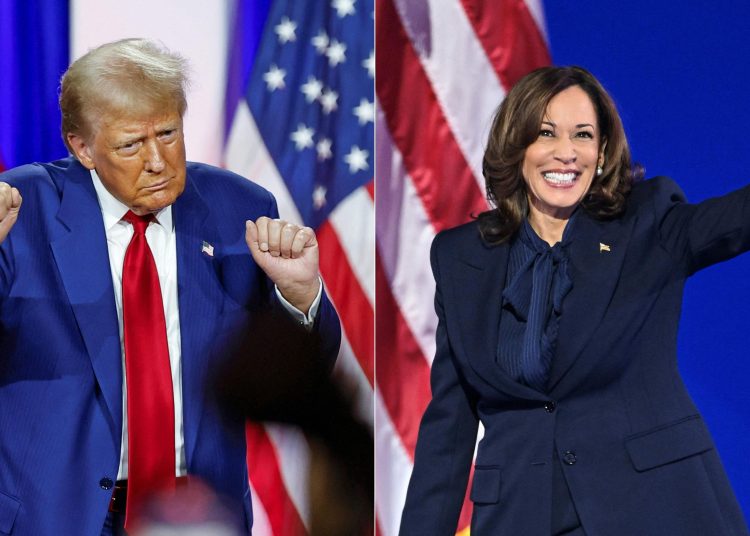Recent developments in West Asia, particularly Israel’s attacks on Gaza and Lebanon and the escalating tensions with Iran, have diverted public attention from the 2024 U.S. presidential election, especially in the Middle East. As the election draws closer, the question remains: which candidate has a better chance of winning?
The political landscape in the United States remains dynamic and unpredictable, with both major candidates locked in a highly competitive race. Multiple factors—ranging from polling data, economic indicators, and demographic shifts to campaign strategies and the performance of key political figures like Vice President Kamala Harris—are influencing the trajectory of the election.
Polling Data and Electoral Margins
Recent polls reveal a tight race between the Democratic and Republican nominees, reflecting deep political polarization across the country. While national polls offer insight into the overall mood of the electorate, it is the swing states, particularly those in the Rust Belt and Sun Belt regions, that hold the key to victory. Historically, elections can be determined by narrow margins in states like Pennsylvania, Michigan, Wisconsin, North Carolina, Arizona, and Georgia. Polling averages from these battlegrounds show fluctuating support, often within the margin of error, suggesting that even slight changes in voter turnout or sentiment could tip the scales.
While RCP poll averages indicate Donald Trump leading with 312 electoral votes compared to Vice President Kamala Harris’ 226, this doesn’t capture the complete picture. In crucial battleground states, four of Trump’s leads are razor-thin: 0.8% in Pennsylvania, 0.4% in North Carolina, 0.4% in Wisconsin, and 0.9% in Michigan. Additionally, three other states show Trump ahead by less than three points: Michigan (1.2%), Arizona (1.8%), and Georgia (2.5%). A minor polling error could easily tip the scales in Harris’ favor.
Moreover, the role of third-party candidates could have a profound impact in some states, siphoning votes from the major party candidates. Analysts point out that if such candidates manage to appeal to disillusioned voters from either side, it could affect the balance in crucial swing states, making the electoral landscape even more volatile.
The Role of Vice President Kamala Harris
Vice President Kamala Harris plays a central role in the campaign, particularly as she seeks to solidify support from the Democratic base while attracting broader segments of the electorate. Harris’s candidacy has sparked significant discussion, both within and outside the Democratic Party, about her ability to connect with key voter blocs, including minorities, women, and young voters. Some political commentators express concern that Harris has struggled to reassure moderate voters and independents, who are vital in a general election. Additionally, the challenge for Harris is to both motivate progressives, who may feel that the administration has not gone far enough on issues like healthcare, climate change, and social justice, while not alienating centrist Democrats.
In contrast, Harris remains a pivotal figure for mobilizing African American voters and other core Democratic constituencies, particularly in states like Georgia and Michigan, where these demographics could be decisive. However, with signs of dissatisfaction within some progressive circles, her role in bridging the party’s ideological divides will be crucial to the outcome.
Economic Factors and the Stock Market’s Impact
The economy is traditionally one of the most decisive factors in US elections, and the 2024 race is no exception. Economic conditions, particularly inflation, job growth, and consumer sentiment, play a pivotal role in shaping voters’ choices. Historically, incumbents tend to fare better when the economy is strong, as voters are more inclined to favor continuity when they feel financially secure. Conversely, economic anxiety—driven by concerns over inflation, rising interest rates, and stagnating wages—can lead to calls for change.
One economic indicator frequently cited as a predictor of electoral outcomes is the stock market. Analysts note that stock market performance in the months leading up to the election often correlates with voter confidence in the incumbent party. A buoyant market suggests optimism and stability, favoring the sitting president’s party, while a decline may indicate economic uncertainty, which could benefit challengers. In the 2024 race, market volatility, combined with lingering inflationary concerns, could work against the incumbent administration.
Tiny Shifts in the Electorate Could Prove Decisive
One of the most striking features of the 2024 election is how small changes in the electorate could have outsized effects on the final result. As noted by numerous political analysts, this election may hinge on marginal shifts in key demographic groups. White suburban voters, who swung toward Democrats in 2020, remain a critical battleground. However, there are indications that some of these voters are reconsidering their allegiance in light of economic concerns and a perceived leftward shift within the Democratic Party.
Additionally, the role of Hispanic and Asian American voters is increasingly important. These groups, once solidly Democratic, have shown signs of moving toward Republicans in recent elections, particularly in states like Florida and Texas. Capturing or retaining these voters will be essential for both parties as they seek to expand their coalitions and build paths to victory.
Campaign Strategies: Ground Game and Voter Engagement
The effectiveness of each candidate’s campaign strategy, particularly their ability to get out the vote, will be pivotal in determining the outcome. In recent election cycles, early voting and absentee ballots have played an increasingly prominent role. Candidates are leveraging digital platforms and targeted outreach to ensure that their supporters vote early, reducing reliance on Election Day turnout alone.
The campaigns are also focusing on energizing key voter groups. Democrats are prioritizing issues like healthcare, reproductive rights, and climate action to mobilize young voters and progressives. Republicans, meanwhile, are hammering on economic issues, crime, and immigration, seeking to appeal to disaffected voters who may have supported Donald Trump in previous elections but are wary of Democratic governance.
Betting Odds and Public Perception
Betting markets, often seen as a real-time indicator of public sentiment, currently suggest that the race is exceedingly close, with odds fluctuating almost daily. While betting odds are not always a perfect predictor of electoral outcomes, they do reflect the evolving perception of which candidate is more likely to win. As Election Day approaches, shifts in these odds may signal changes in voter enthusiasm, the effectiveness of campaign messages, or unexpected developments that could sway undecided voters.
Conclusion: A Closely Contested Election
As the 2024 US presidential election nears, it remains a remarkably close contest, with no clear frontrunner at this stage. The outcome will likely be shaped by a convergence of factors, including polling data, economic conditions, demographic shifts, and the effectiveness of each campaign’s voter engagement efforts. Vice President Kamala Harris’s role will be instrumental in rallying the Democratic base, while economic concerns and marginal shifts in key demographic groups could prove decisive.
In such a tightly contested race, every vote will count, and minor changes in voter behavior across a handful of states could ultimately determine the next occupant of the White House. With the political environment as polarized and uncertain as it is, predicting the eventual winner remains a challenge, making this one of the most unpredictable elections in modern US history.






